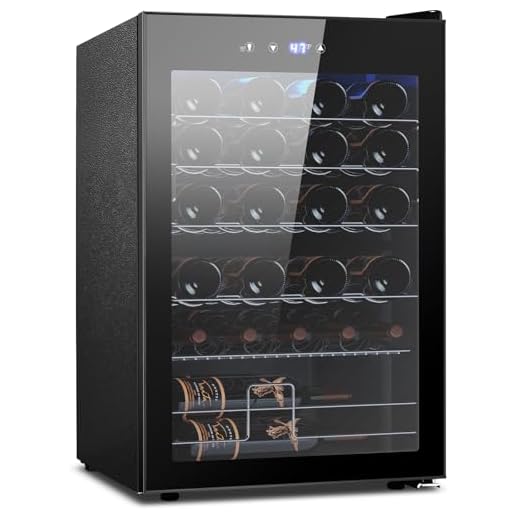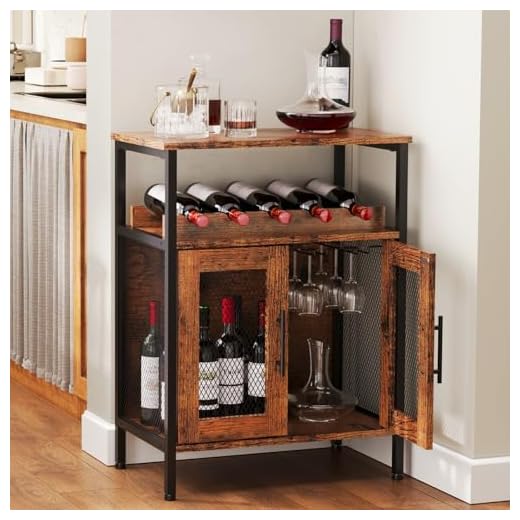



Keep your bottles at a consistent temperature, ideally between 50°F and 65°F. While many believe that a cool environment enhances flavor preservation, not every option is suitable for every type of bottle. The question of refrigeration often arises, especially concerning certain varieties that may benefit from a chill.
For optimal enjoyment, consider the characteristics of the beverage. Certain blends can thrive at slightly cooler temperatures, bringing out their fruity notes and balancing tannins. However, prolonged exposure to cold can lead to undesirable effects, such as muted flavors and a lack of complexity.
Instead of long-term chilling, utilize a wine cooler or a dedicated space in your home that maintains an ideal climate. If you need to chill a bottle quickly, placing it in an ice bucket or a quick stint in the cooler can elevate your experience without compromising quality. Remember, the goal is to enhance enjoyment while respecting the nuances of each varietal.
Optimal Conditions for Storing Your Favorite Varietals
Place your favorite varietals in a cool, dark environment with minimal temperature fluctuations. Aim for a consistent temperature between 55°F and 65°F (13°C to 18°C). Humidity levels should be around 70% to prevent corks from drying out.
While the common practice is to chill lighter types, there are exceptions. If you enjoy a more refreshing experience, consider serving certain styles slightly cooler, around 60°F (15°C). This can enhance fruitiness and balance tannins.
Factors to Consider
| Factor | Recommendation |
|---|---|
| Light Exposure | Keep away from direct sunlight; UV rays can damage the liquid. |
| Vibration | Avoid areas with constant movement; vibrations can disrupt sediment. |
| Storage Position | Store bottles horizontally to keep corks moist, preventing air ingress. |
Utilize a dedicated storage unit or wine cellar that maintains ideal conditions. If you have to use a standard cooling appliance, ensure it is set to a proper temperature and not too cold. Enjoy your collection with proper care, ensuring each bottle reaches its fullest potential when opened.
Impact of Temperature on Flavor
Serving temperature significantly influences the taste profile of a specific varietal. For optimal enjoyment, aim for a range between 60°F and 65°F (15°C to 18°C). Below this threshold, aromas and flavors can become muted, making it challenging to appreciate the complexity of the drink. Conversely, temperatures exceeding 70°F (21°C) can lead to an overwhelming alcoholic presence, overshadowing subtle nuances.
Temperature management is crucial during tasting. At lower temperatures, fruity notes may recede, while higher temperatures can amplify tannins, resulting in a harsher mouthfeel. Allowing an uplift in warmth can enhance aromatic expression, revealing layers of spice, earthiness, and fruit that might otherwise remain hidden.
Consider specific varietals: a light-bodied choice benefits from a cooler setting, showcasing its refreshing qualities. Conversely, a full-bodied selection thrives at slightly elevated warmth, allowing for a richer, more rounded experience. Experimenting within this temperature spectrum can lead to delightful discoveries in flavor profiles.
For those keen on enhancing their sensory experience, utilizing a thermometer can help achieve precision. Regularly monitoring temperature ensures that each pour delivers its full potential. This attention to detail not only elevates enjoyment but also deepens appreciation for the craftsmanship behind each bottle.
Best Practices for Storing Opened Wine
After uncorking a bottle, protect the remaining liquid by following these guidelines. First, reseal the bottle with its cork or a vacuum stopper to minimize air exposure. This helps maintain the original taste profile for a longer period.
Optimal Temperature
Maintain a consistent cool environment. A temperature range of 55°F to 65°F is ideal. If you prefer to chill, place the bottle in a cooler area, avoiding drastic temperature fluctuations that can compromise flavor integrity.
Positioning
Store the bottle upright to reduce contact with oxygen. This prevents oxidation and preserves the character of the beverage. Keep it away from direct sunlight and heat sources, which can degrade quality over time.
For longer preservation, consider transferring the contents into a smaller container to minimize air exposure. Taking these steps will enhance your enjoyment of the remaining portions, ensuring that each glass reflects its intended flavors.
Types of Red Wine That Benefit from Chilling
Light-bodied varieties thrive when slightly chilled, enhancing their refreshing nature. Think of a Gamay from Beaujolais – its fruit-forward profile and low tannins make it an excellent candidate for a cooler temperature. Serving it around 55°F (13°C) accentuates its juicy flavors and makes it incredibly enjoyable on a warm day.
Another example is Pinot Noir, particularly those from cooler regions like Oregon or Burgundy. When cooled to about 55°F (13°C), the delicate aromas and subtle flavors of cherry and earth come alive, making it a delightful pairing with grilled salmon or chicken dishes.
Chilling for Fruity and Spicy Varieties
Varieties known for their fruitiness, such as Dolcetto and some Grenache-based blends, also benefit from a slight chill. Keeping these wines at around 54°F (12°C) enhances the berry notes while softening any harsh edges, creating a balanced tasting experience. These wines pair well with charcuterie boards or pizza, making them versatile choices for casual gatherings.
Exploring Unique Options
Don’t overlook lesser-known varietals like Frappato or Zweigelt. These wines, when slightly chilled, can offer a unique tasting experience. At around 53°F (12°C), their bright acidity and flavor complexity shine, making them perfect companions for dishes with robust spices. Experimenting with these options can lead to exciting discoveries in your wine journey.
How Long Can Red Wine Be Refrigerated?
Typically, it’s advisable to keep a bottle in a chilled environment for no more than three to five days once opened. Beyond this timeframe, flavors begin to deteriorate, and the overall experience can be noticeably affected.
For longer periods, consider these guidelines:
- Seal the bottle tightly with a cork or a wine stopper to minimize oxidation.
- Store upright to reduce the surface area exposed to air.
- Avoid frequent temperature fluctuations, which can compromise quality.
While some varieties may retain their integrity for a week or more, most will benefit from consumption within a few days. If aromas and taste begin to fade, it’s best to enjoy the remaining contents sooner rather than later.
When chilling, be mindful of how it interacts with various styles. Light-bodied options may thrive in cooler conditions, while fuller-bodied selections might lose complexity if kept too cold for extended durations.
Alternatives to Refrigeration for Red Wine Storage
For those looking to preserve their favorite bottles without resorting to chilling, several effective methods exist. A dedicated wine cabinet, maintained at a consistent temperature, can create an optimal environment, mimicking cellar conditions. These cabinets often allow for precise temperature control, humidity management, and UV protection.
If a wine cabinet isn’t an option, a dark, cool closet or a basement can serve as a suitable substitute. Aim for a temperature range of 55°F to 65°F (13°C to 18°C) to maintain flavor integrity. Ensure that the area is free from strong odors, vibrations, and direct sunlight, all of which can diminish quality over time.
Utilizing a wine rack designed for horizontal storage keeps corks moist, preventing oxidation. Additionally, investing in a wine preservation system can help extend the life of opened bottles. These devices work by removing air from the bottle, thus slowing down the oxidation process and keeping flavors intact.
For immediate consumption of specific varieties that benefit from a slight chill, I recommend using an ice bucket filled with water and ice for about 15-20 minutes. This method allows for a quick temperature adjustment without compromising storage practices. If you’re looking for a delightful meal to accompany your choice, consider exploring how to cook langoustines in garlic butter.
Lastly, remember to always handle bottles carefully and avoid excessive movement, as this can disturb sediment and affect taste. Following these guidelines can enhance your enjoyment and appreciation of every pour.
FAQ:
Is it okay to store red wine in the refrigerator?
Storing red wine in the refrigerator is generally acceptable, especially if the wine will be consumed within a short period. The cooler temperature can help preserve the wine’s flavors and aromas. However, it’s best to allow the wine to reach its ideal serving temperature before drinking, which is typically slightly below room temperature for most red wines. If you plan on storing the wine for an extended period, a wine cellar or a wine fridge might be more appropriate to maintain optimal conditions.
How long can red wine be kept in the refrigerator?
Red wine can be kept in the refrigerator for a few days to a week after opening, depending on the type of wine and its tannin structure. Wines with higher tannins tend to last longer. If the bottle is sealed properly, the wine can remain drinkable for a short while. For best results, it’s advisable to consume the wine within a few days of opening, as oxidation can alter its taste over time.
Does refrigeration affect the taste of red wine?
Refrigeration can impact the taste of red wine, particularly if it is stored at too low a temperature for too long. While a brief stay in the fridge can help maintain freshness, prolonged refrigeration might mute some of the wine’s flavors and aromas. It’s recommended to take the wine out of the refrigerator about 30 minutes before serving to allow it to warm up slightly. This helps to enhance its flavor profile and brings out the characteristics that make it enjoyable.










